Study on Solar Radiation and the Extreme Thermal Effect on Concrete Box Girder Bridges
Abstract
:1. Introduction
2. Calculation Method of Solar Radiation and Field Temperature Observing
2.1. Determination of the Solar Radiation Parameters
2.2. Determination of the Heat Transfer Parameters
2.3. The Background Engineering and Field Temperature Observing
3. The Variation and Impact of Solar Radiation
3.1. The Solar Radiation Variation
3.2. Temperature Field Analysis and the Finite Element Numerical Simulation
3.3. The Variation of Temperature Difference
4. The Estimated Extreme Temperature Condition of the Bridge in the Design Lifetime
4.1. Historical Meteorological Data
4.2. Extreme Values of Meteorological Data Based on Generalized Extreme Value Distribution
5. Numeral Example of the Box Girder Thermal Effect under Solar Radiation and the Extreme Temperature Condition
6. Conclusions
- (1)
- The solar radiation changes obviously with time on different surfaces of the box girder. It arrives at the maximum value and keeps stable from 10:00 to 16:00 on the top deck. For the surfaces without direct sunlight, it changes slowly due to scattering and reflection radiation.
- (2)
- The effective depth due to solar radiation is about 30 cm, and the sunlight side web overall temperature is higher than that of the sheltered web. The impact of the temperature difference factors shows that direct solar radiation has the most significant effect on the temperature difference. The maximum value of the top slab is 19.8 °C, which appears at 16:00.
- (3)
- A method of estimating the extreme thermal condition is presented. The extreme temperature is fitted by GEV distribution based on the historical meteorological data. The estimated highest air temperature with a return period of 100 years at the bridge site is 33.1 °C, the most significant daily temperature difference is 14.7 °C, and a minimum daily average wind speed with a 10-year return period is 0.5 m/s. Then, the extreme thermal condition is obtained by combining the above meteorological data and solar radiation.
- (4)
- Under solar radiation and extreme thermal condition, the maximum temperature difference of the girder slab is 22.2% larger than that on the measured day. With it as the most unfavorable condition, the thermal stress of the cross-section was calculated. The maximum transversal tensile stress is 3.0 MPa, and the minimum compressive stress is −7.6 MPa; the maximum vertical tensile stress and the minimum compressive stress are 0.9 MPa and −2.4 MPa, respectively. The tensile stress has exceeded the specified design value of the code and could cause cracks, and the maximum tensile stress is 50% larger the design strength in the code. Therefore, in practical engineering, the structural reinforcements should be added on the inner surface of the top deck and the lower edge of the web plate according to the obtained tensile stress distribution.
Author Contributions
Funding
Institutional Review Board Statement
Informed Consent Statement
Data Availability Statement
Conflicts of Interest
References
- Liu, Y.J.; Liu, J.; Zhang, N. Review on solar thermal actions of bridge structures. China Civ. Eng. J. 2019, 52, 59–78. [Google Scholar]
- Gottsäter, E.; Ivanov, O.L.; Molnár, M.; Crocetti, R.; Nilenius, F.; Plos, M. Simulation of thermal load distribution in portal frame bridges. Eng. Struct. 2017, 143, 219–231. [Google Scholar] [CrossRef]
- Lee, J.H.; Kalkan, I. Analysis of thermal environmental effects on precast, prestressed concrete bridge girders: Temperature differentials and thermal deformations. Adv. Struct. Eng. 2012, 15, 447–459. [Google Scholar] [CrossRef]
- Abou-Zeid, M.; Fowler, D.W.; Nawy, E.G.; Allen, J.H.; Halvorsen, G.T.; Poston, R.W.; Barlow, J.P.; Hansen, W.; Rhoads, R.J.; Brander, M.E.; et al. Control of cracking in concrete structures. Rep. ACI Comm. 2001, 224, 12–16. [Google Scholar]
- Sheng, X.; Yang, Y.; Zheng, W.; Zhou, B.; Li, S.; Huang, L. Study on the time-varying temperature field of small radius curved concrete box girder bridges. AIP Adv. 2020, 10, 105013. [Google Scholar] [CrossRef]
- Dai, G.; Tang, Y.; Liang, J.; Yang, L.; Chen, Y.F. Temperature monitoring of high-speed railway bridges in mountainous areas. Struct. Eng. Int. 2018, 28, 288–295. [Google Scholar] [CrossRef]
- Dai, G.L.; Tang, Y.; Chen, Y.F.; Liang, J.B.; Yang, L.H. Some issues on temperature model of box girder in HSR. In Proceedings of the 8th International Conference on Structural Health Monitoring of Intelligent Infrastructure (SHMII), Brisbane, Australia, 5–8 December 2017; pp. 1475–1484. [Google Scholar]
- Zhang, C.; Liu, Y.; Liu, J.; Yuan, Z.; Zhang, G.; Ma, Z. Validation of long-term temperature simulations in a steel-concrete composite girder. In Structures; Elsevier: Amsterdam, The Netherlands, 2020; Volume 27, pp. 1962–1976. [Google Scholar]
- Gottsäter, E.; Larsson Ivanov, O. Spatial temperature differences in portal frame bridges. Struct. Eng. Int. 2020, 30, 254–261. [Google Scholar] [CrossRef] [Green Version]
- Tomé, E.S.; Pimentel, M.; Figueiras, J. Structural response of a concrete cable-stayed bridge under thermal loads. Eng. Struct. 2018, 176, 652–672. [Google Scholar] [CrossRef]
- Westgate, R.; Koo, K.Y.; Brownjohn, J. Effect of solar radiation on suspension bridge performance. J. Bridge Eng. 2015, 20, 04014077. [Google Scholar] [CrossRef] [Green Version]
- Branco, F.A.; Mendes, P.A. Thermal actions for concrete bridge design. J. Struct. Eng. 1993, 119, 2313–2331. [Google Scholar] [CrossRef]
- Song, Z.; Xiao, J.; Shen, L. On temperature gradients in high-performance concrete box girder under solar radiation. Adv. Struct. Eng. 2012, 15, 399–415. [Google Scholar] [CrossRef]
- Kim, S.H.; Park, S.J.; Wu, J.; Won, J.-H. Temperature variation in steel box girders of cable-stayed bridges during construction. J. Constr. Steel Res. 2015, 112, 80–92. [Google Scholar] [CrossRef]
- Zhou, L.; Xia, Y.; Brownjohn, J.M.; Koo, K.Y. Temperature analysis of a long-span suspension bridge based on field monitoring and numerical simulation. J. Bridge Eng. 2016, 21, 04015027. [Google Scholar] [CrossRef]
- Tayşi, N.; Abid, S. Temperature distributions and variations in concrete box-girder bridges: Experimental and finite element parametric studies. Adv. Struct. Eng. 2015, 18, 469–486. [Google Scholar] [CrossRef]
- Lee, Y.; Choi, M.S.; Yi, S.T.; Kim, J.K. Experimental study on the convective heat transfer coefficient of early-age concrete. Cem. Concr. Compos. 2009, 31, 60–71. [Google Scholar] [CrossRef]
- Dilger, W.H.; Ghali, A.; Chan, M.; Cheung, M.S.; Maes, M.A. Temperature stresses in composite box girder bridges. J. Struct. Eng. 1983, 109, 1460–1478. [Google Scholar] [CrossRef]
- Guo, L.; Guo, L.; Zhong, L.; Zhu, Y. Thermal conductivity and heat transfer coefficient of concrete. J. Wuhan Univ. Technol.-Mater. Sci. Ed. 2011, 26, 791–796. [Google Scholar] [CrossRef]
- Lacis, A.A.; Hansen, J. A parameterization for the absorption of solar radiation in the earth’s atmosphere. J. Atmos. Sci. 1974, 31, 118–133. [Google Scholar] [CrossRef]
- Wang, Z.W.; Zhang, W.M.; Tian, G.M.; Liu, Z. Joint values determination of wind and temperature actions on long-span bridges: Copula-based analysis using long-term meteorological data. Eng. Struct. 2020, 219, 110866. [Google Scholar] [CrossRef]
- Liu, Y.; Su, H.T.; Dai, G. Study on Temperature Fields of Simply-supported Box Girder under Solar Radiation in Passenger Dedicated Lines Based on Meteorological Conditions. J. China Railw. Soc. 2019, 2, 154–159. [Google Scholar]
- Xiao, J.; Song, Z.; Zhao, Y. Analysis of solar temperature action for concrete structure based on meteorological parameters. China Civ. Eng. J. 2010, 43, 30–36. [Google Scholar]
- Lucas, J.M.; Virlogeux, M.; Louis, C. Temperature in the box girder of the normandy bridge. Struct. Eng. Int. 2005, 15, 156–165. [Google Scholar] [CrossRef]
- Ding, Y.L.; Wang, G.X. Estimating extreme temperature differences in steel box girder using long-term measurement data. J. Cent. South Univ. 2013, 20, 2537–2545. [Google Scholar] [CrossRef]
- Sayigh, A.A.M. (Ed.) Solar Energy Engineering; Elsevier: Amsterdam, The Netherlands, 2012. [Google Scholar]
- Kehlbeck, F. Einfluss der Sonnenstrahlung bei Brückenbauwerken; Werner-Verlag: Berlin, Germany, 1975. [Google Scholar]
- Froli, M.; Hariga, N.; Nati, G.; Orlandini, M. Longitudinal thermal behaviour of a concrete box girder bridge. Struct. Eng. Int. 1996, 6, 237–242. [Google Scholar] [CrossRef]
- GB 50010-2010. Code for Design of Concrete Structures; Ministry of House and Urban-Rural Development of People’s Republic of China: Beijing, China, 2010. [Google Scholar]
- JTG 3362–2018. Code for Design of Highway Reinforced Concrete and Pre-Stressed Concrete Bridges and Culverts; China Communications Press: Beijing, China, 2018. [Google Scholar]
- Elbadry, M.M.; Ghali, A. Temperature variations in concrete bridges. J. Struct. Eng. 1983, 109, 2355–2374. [Google Scholar] [CrossRef]
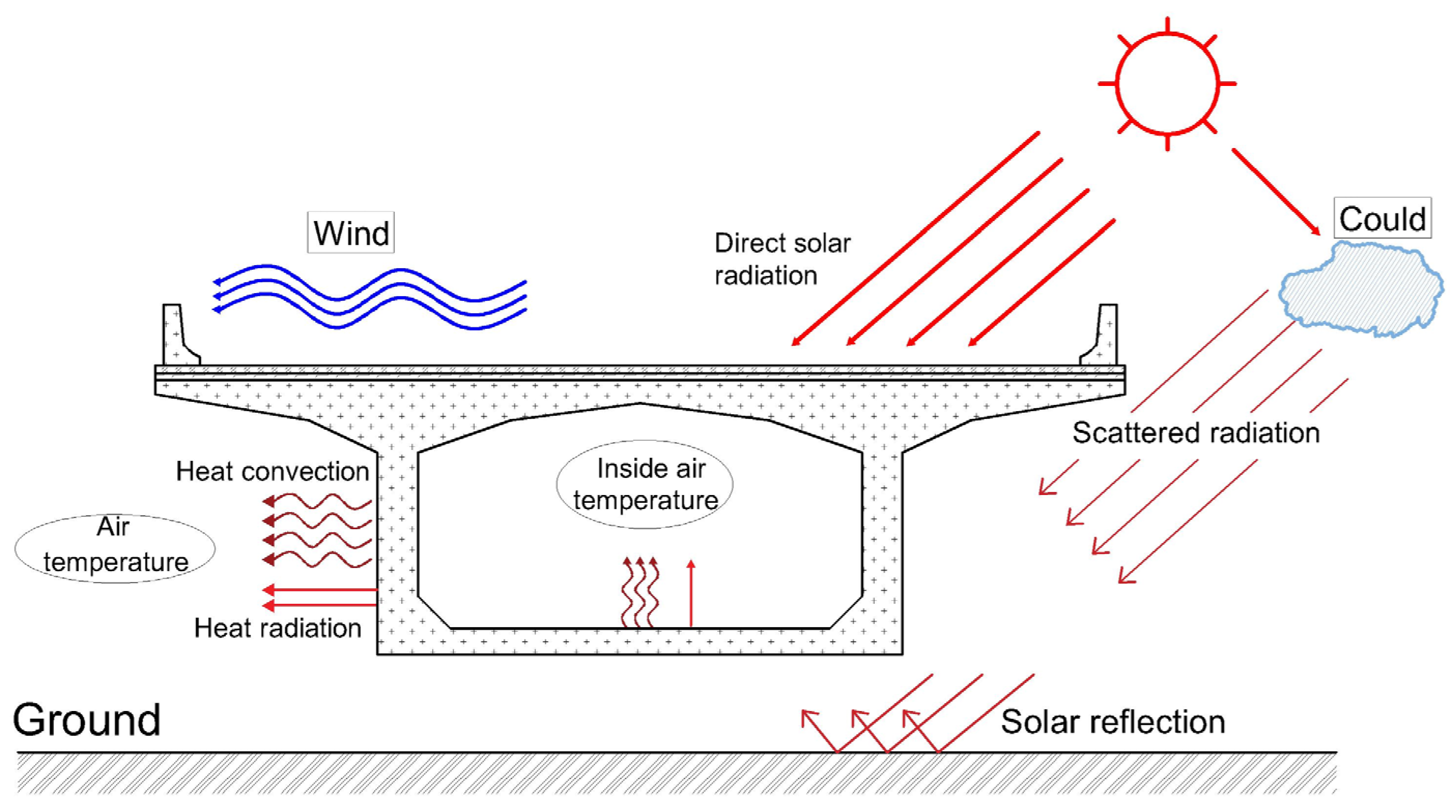
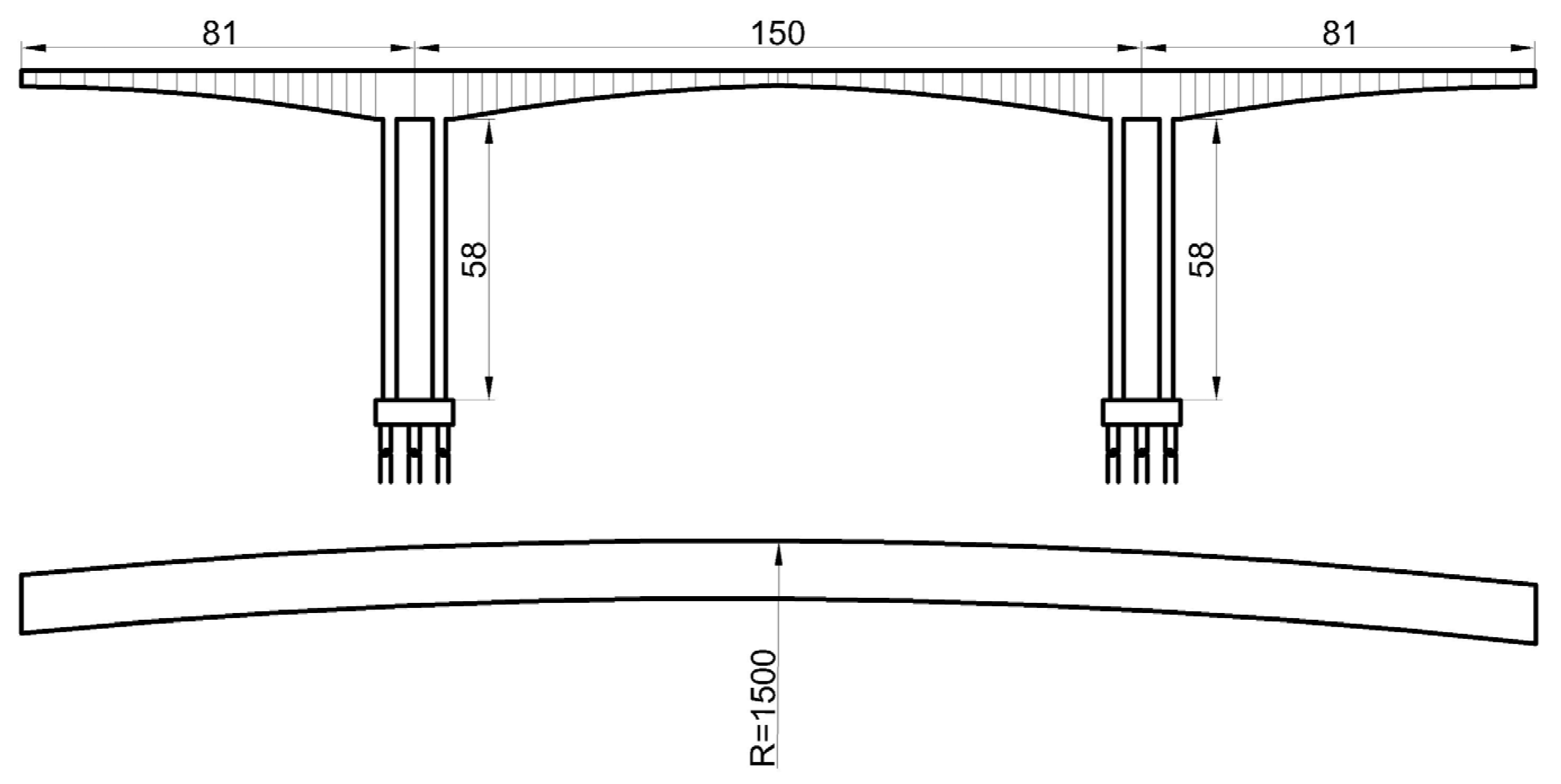

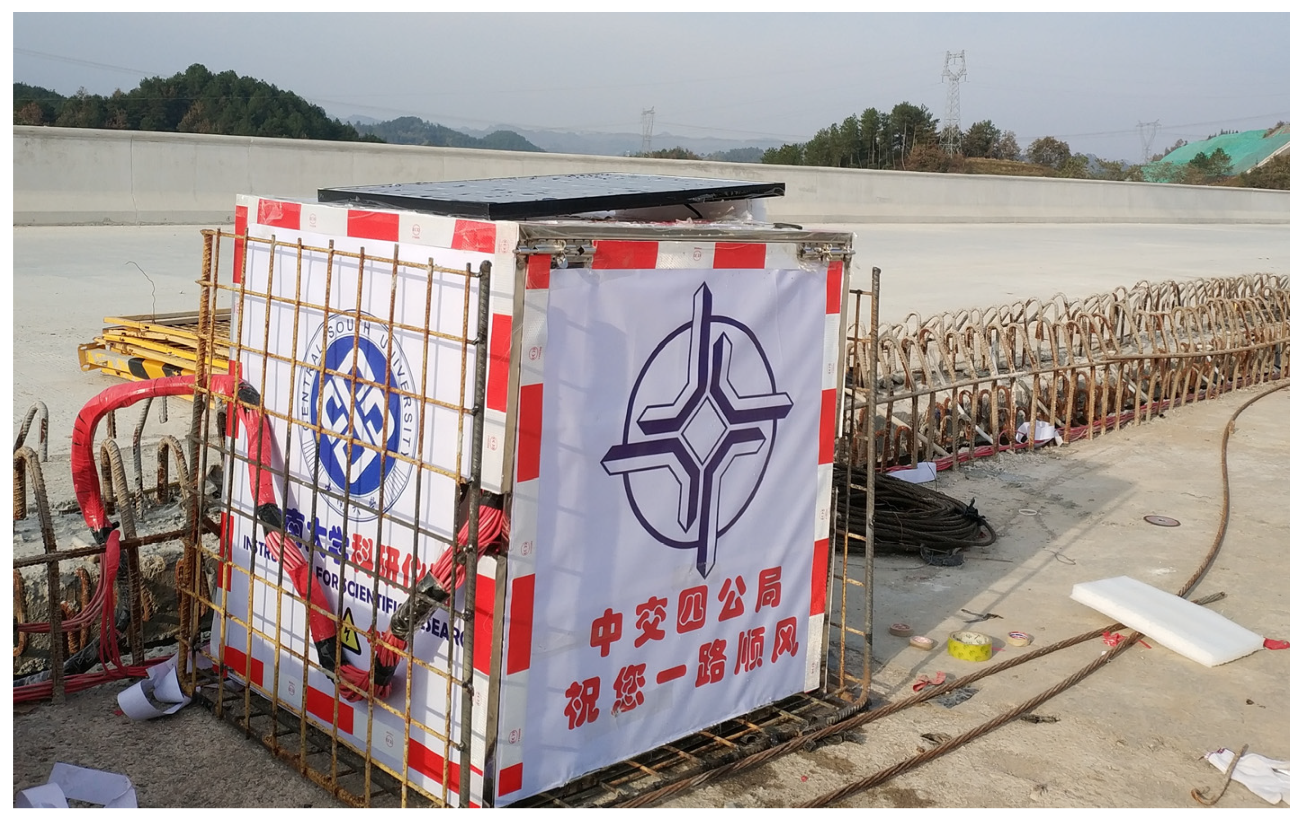

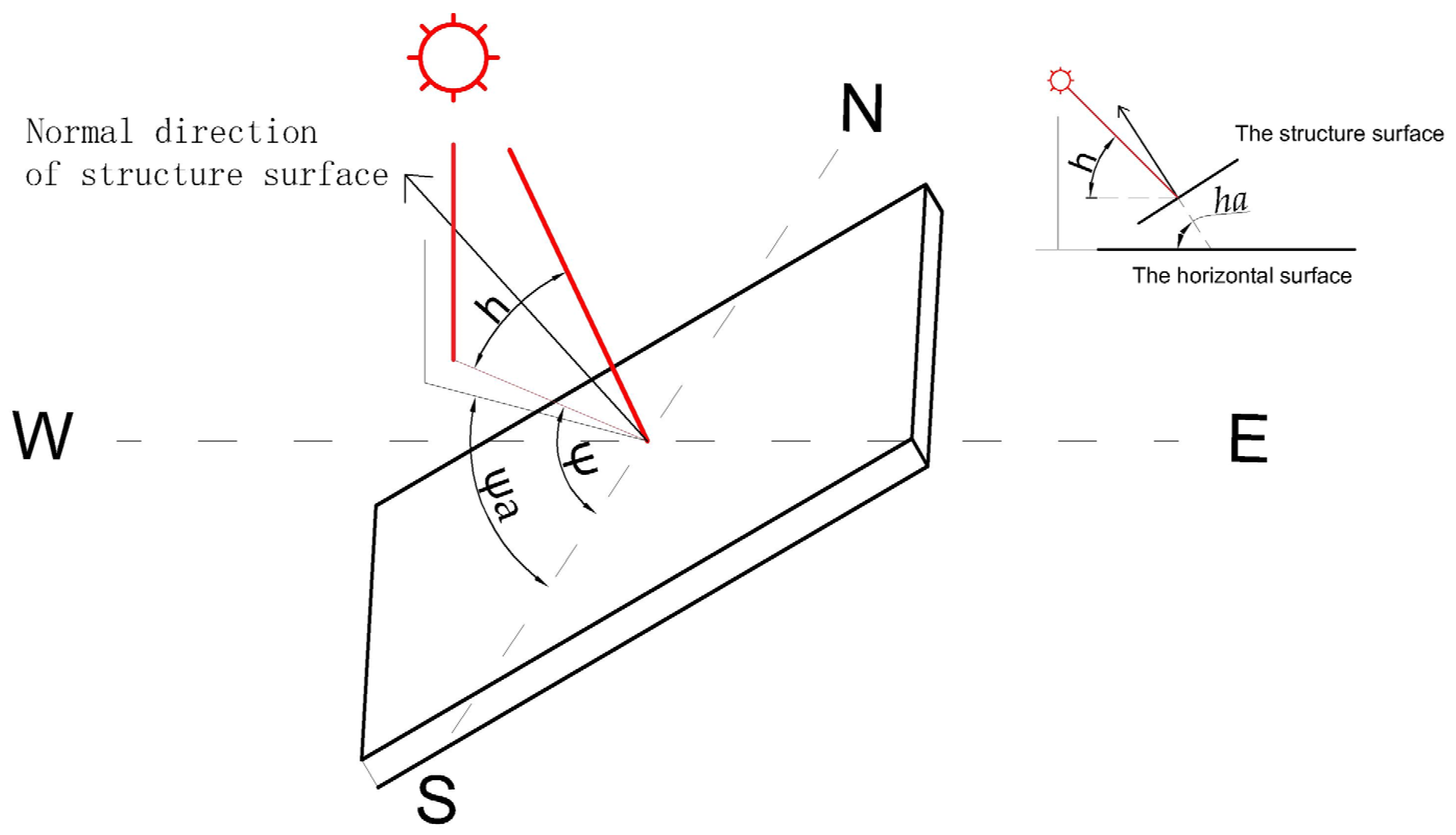
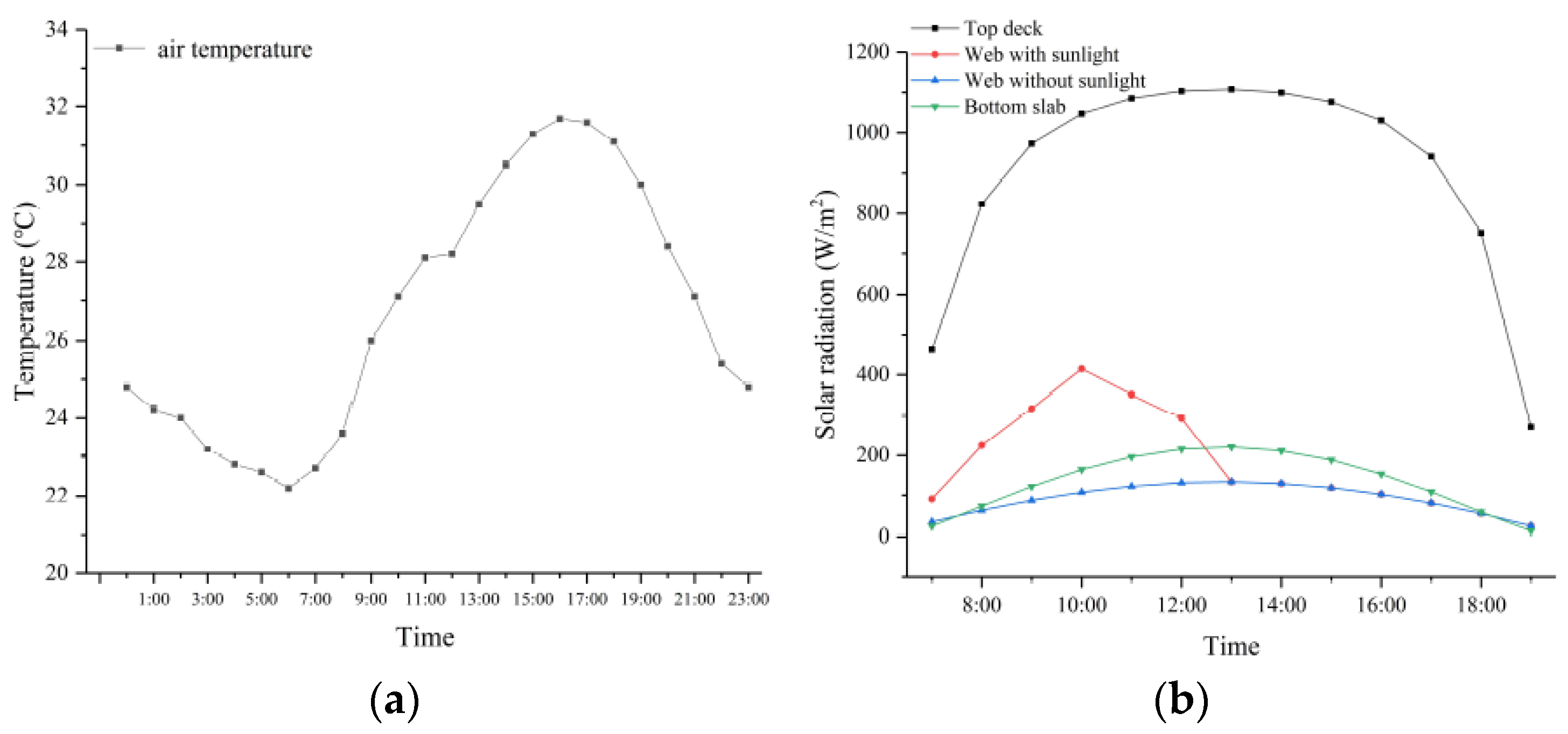
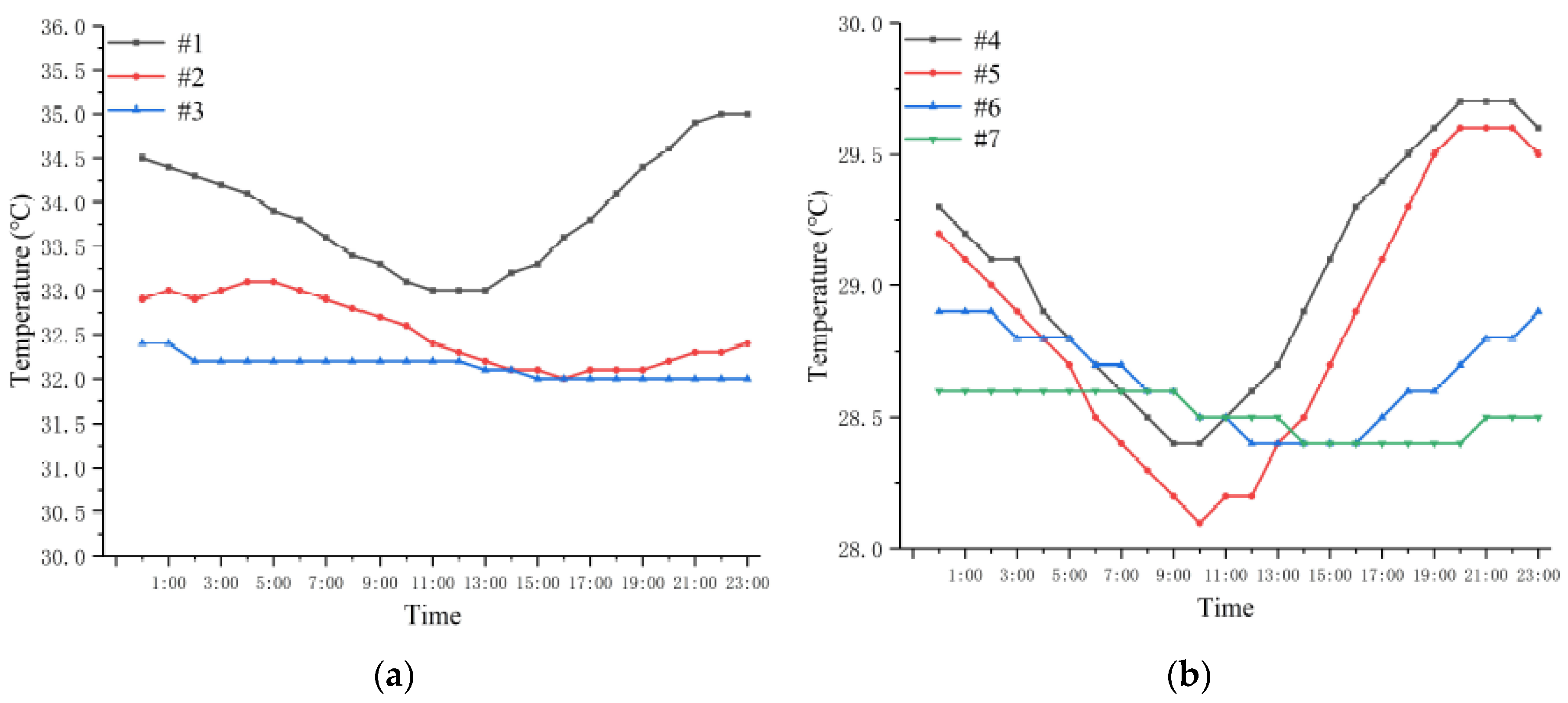
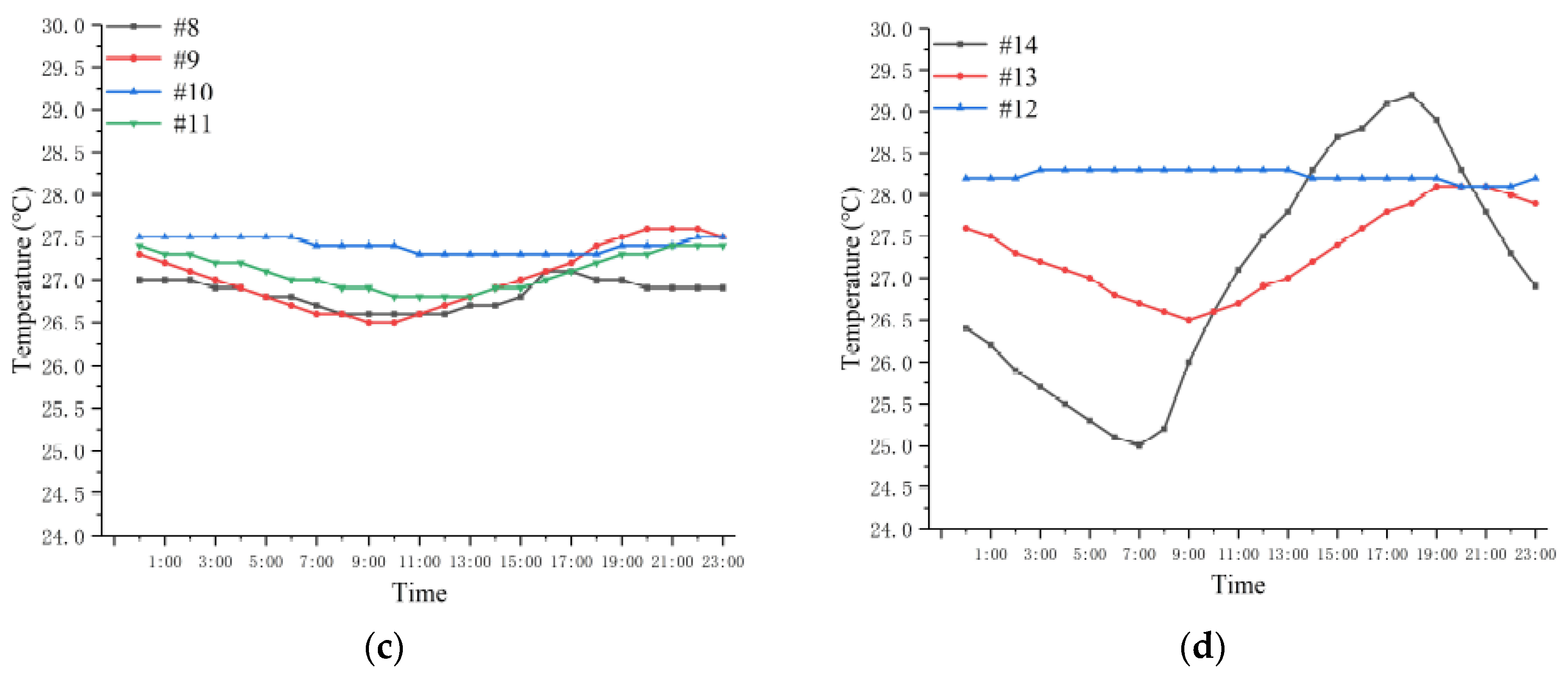
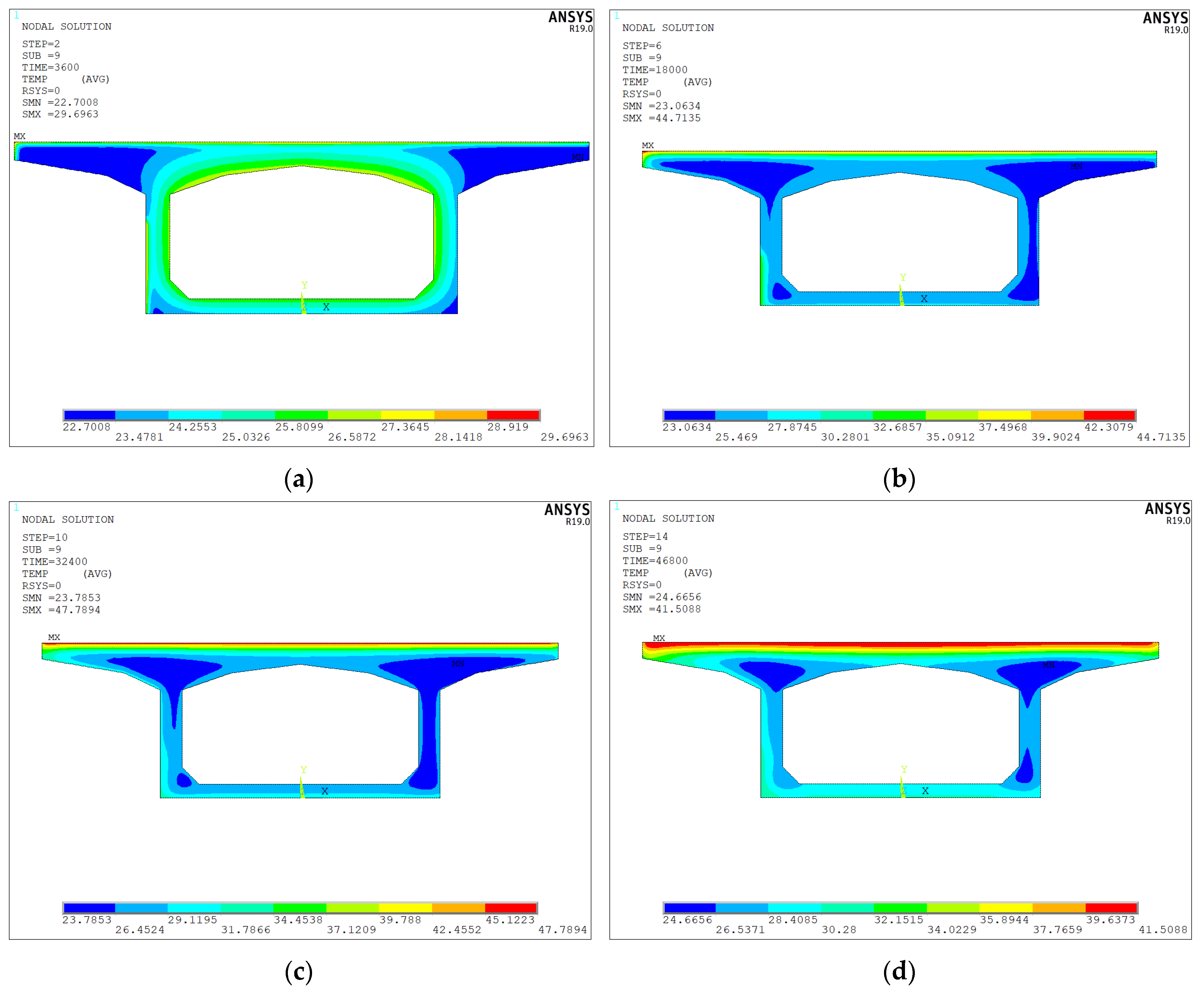
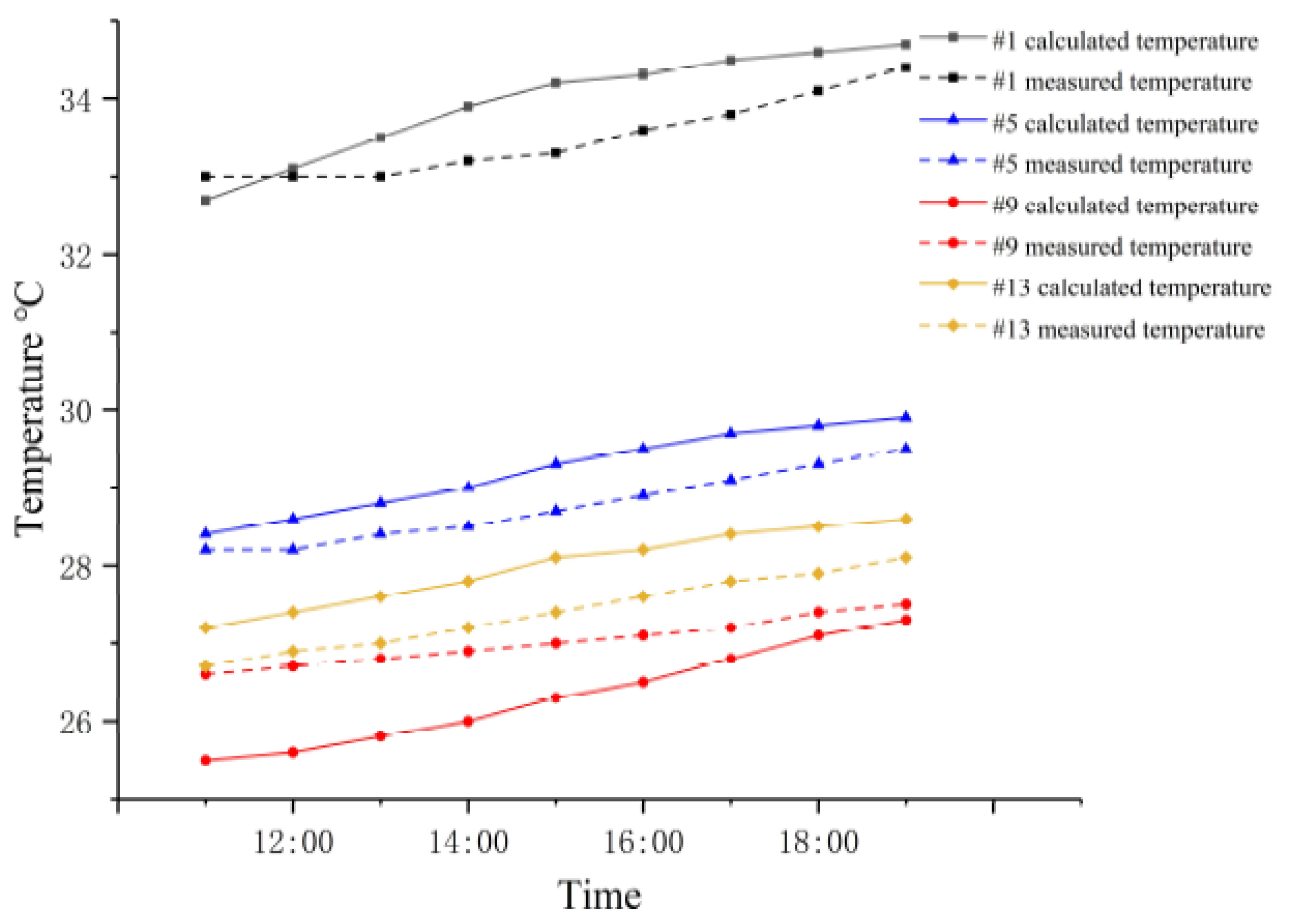
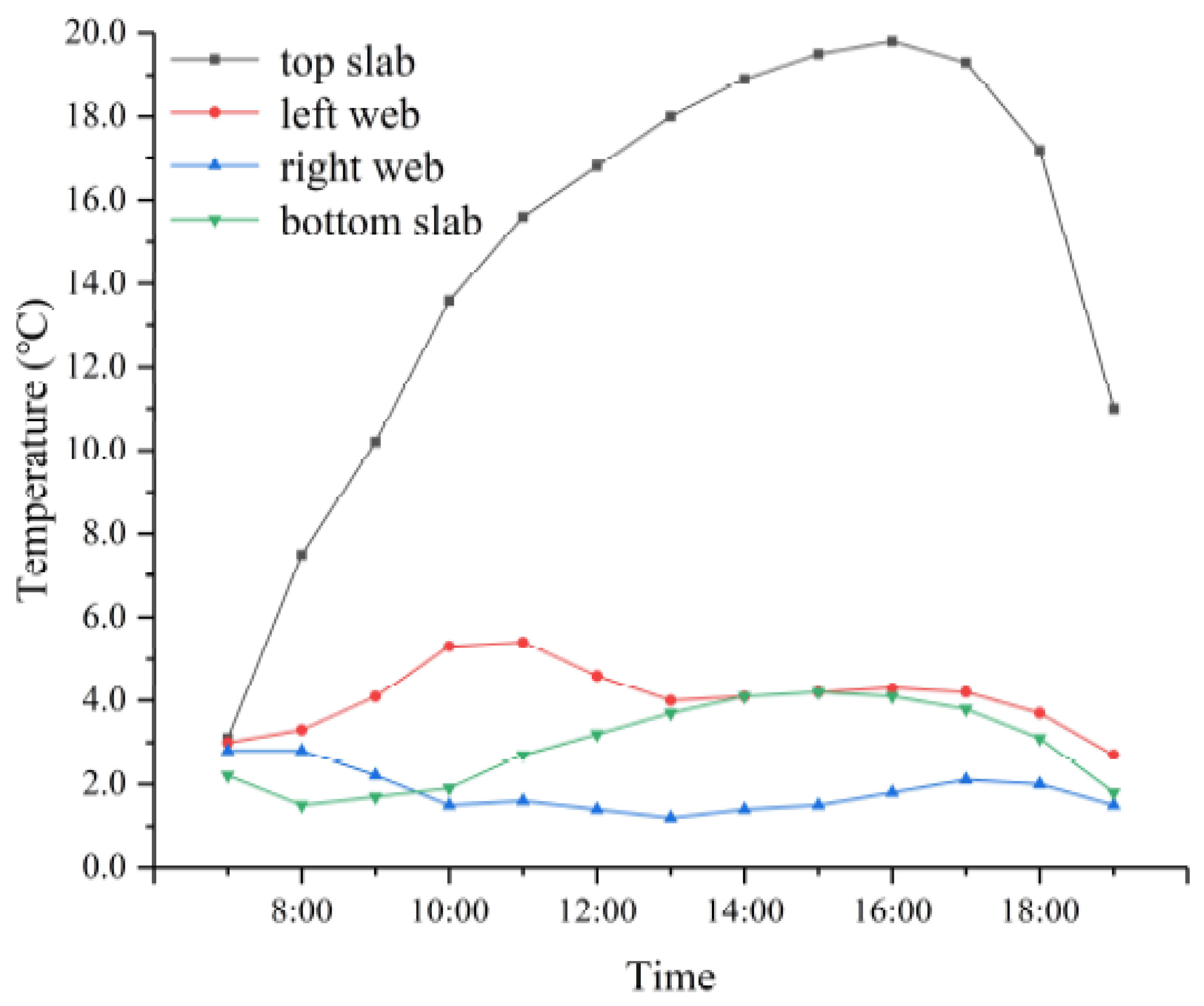
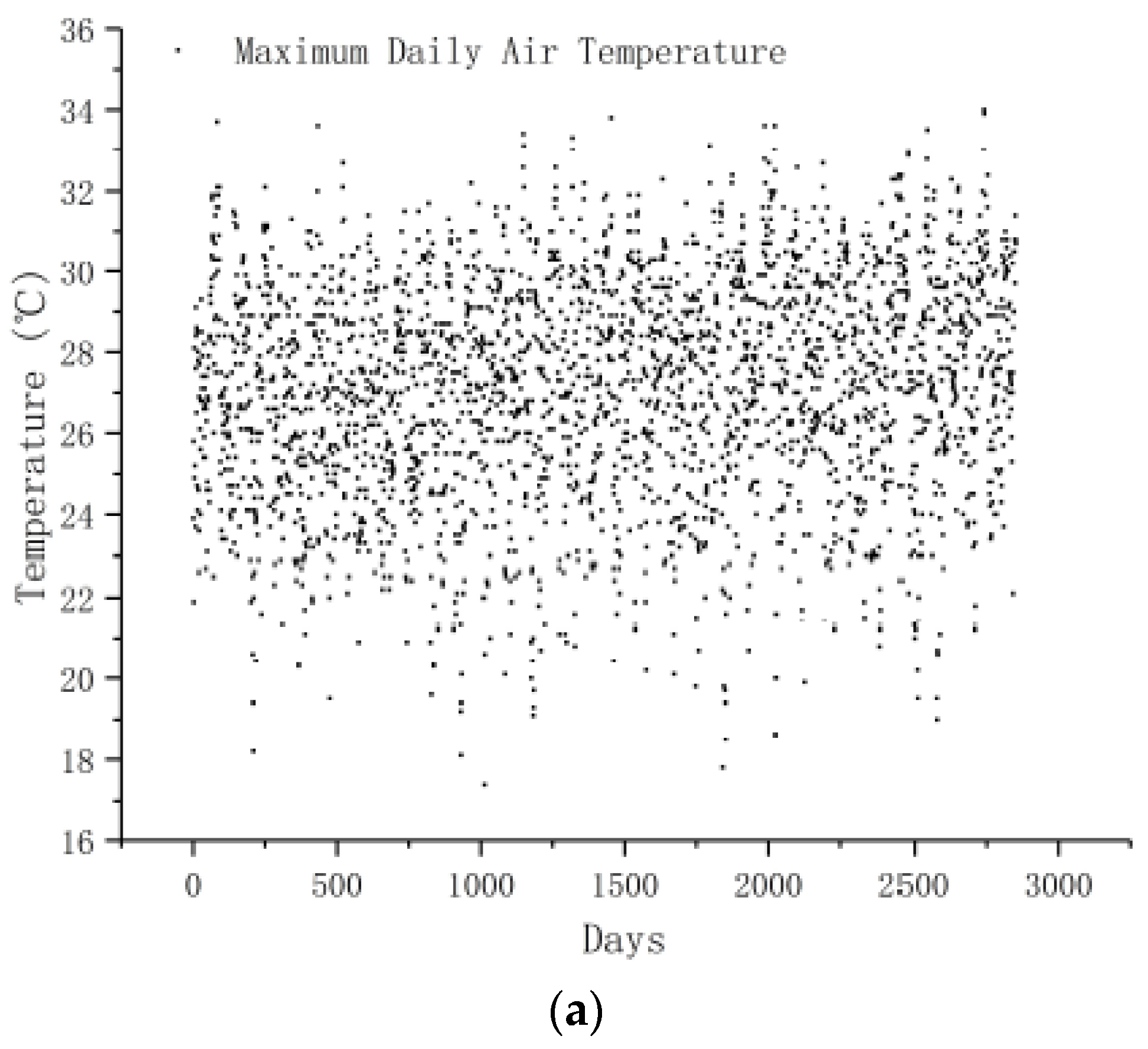

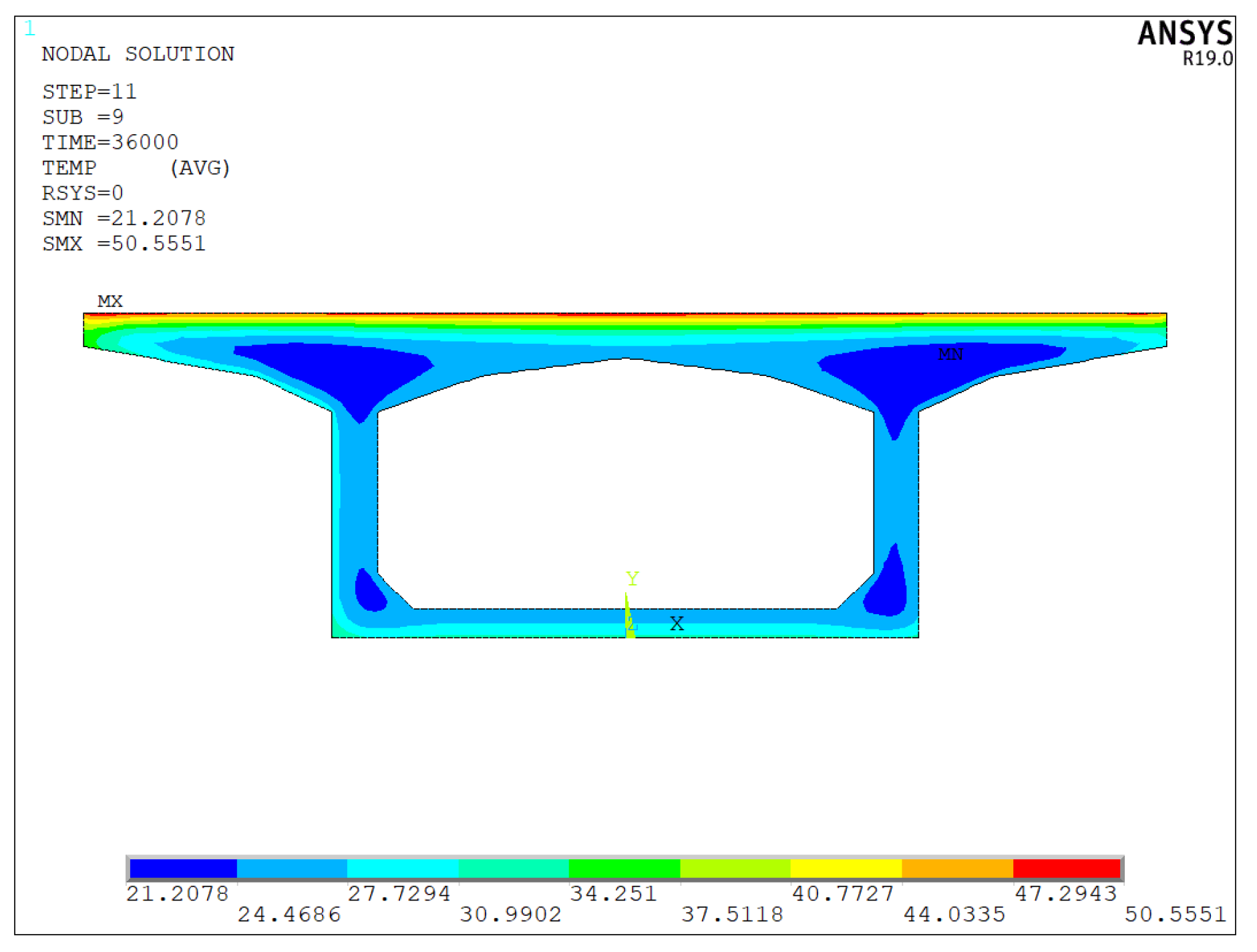
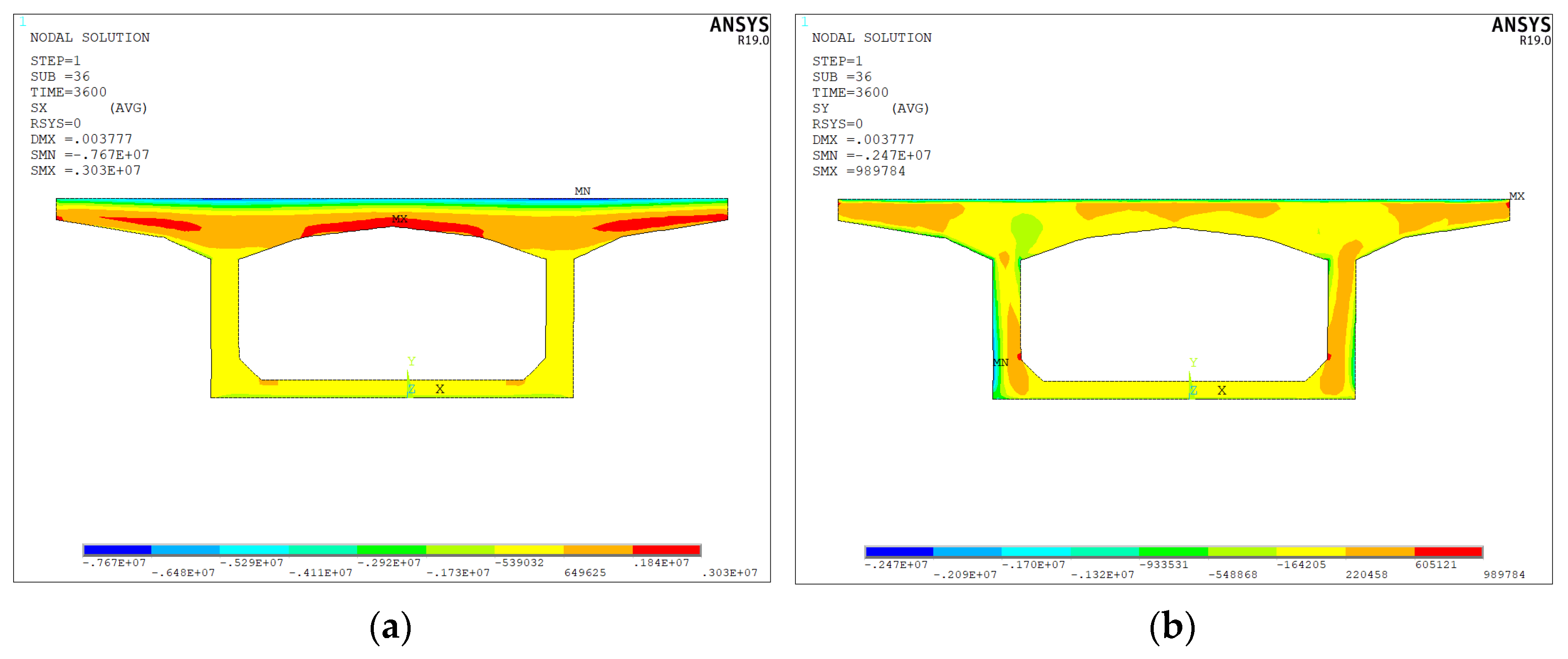
| Solar Radiation Type | Number of Surfaces |
|---|---|
| Horizontal solar radiation | 7 |
| Vertical solar radiation | 2,6 |
| Only horizontal scattering and reflection | 1,4,5 |
| Only vertical scattering and reflection | 3 |
| No solar radiation | 8–11 |
| Density | Specific Heat c | Thermal Conductivity | Elastic Module | Linear Expansion Coefficient | Poisson’s Ratio |
|---|---|---|---|---|---|
| 2600 kg/m3 | 910 J/(kg·°C) | 2.7 W/(m·°C) | 3.45 × 104 MPa | 1 × 10−5 °C | 0.2 |
| Surface Albedo | Wind Speed, | Surface Emissivity | Radiation Absorption | Inner Surface Integrated Heat Transfer Coefficient | Stefan–Boltzmann Constant |
|---|---|---|---|---|---|
| 0.2 | 1.5 m/s | 0.88 | 0.5 | 11.05 W/(m2·°C) | 5.67 × 10−8 W/(m2·K4) |
| Time | Time | ||
|---|---|---|---|
| 6:00 | 16.73 | 13:00 | 17.19 |
| 7:00 | 16.81 | 14:00 | 17.24 |
| 8:00 | 16.86 | 15:00 | 17.29 |
| 9:00 | 16.99 | 16:00 | 17.31 |
| 10:00 | 17.05 | 17:00 | 17.35 |
| 11:00 | 17.11 | 18:00 | 17.31 |
| 12:00 | 17.11 | 19:00 | 17.22 |
| Position | Maximum Temperature Difference (Time) | Temperature Difference Variation Range |
|---|---|---|
| Top slab 1 | 19.8 °C (16:00) | 16.7 °C |
| Left web 2 | 5.4 °C (11:00) | 2.7 °C |
| Bottom slab 3 | 4.2 °C (15:00) | 2.7 °C |
| Right web 4 | 2.8 °C (6:00) | 1.7 °C |
Publisher’s Note: MDPI stays neutral with regard to jurisdictional claims in published maps and institutional affiliations. |
© 2021 by the authors. Licensee MDPI, Basel, Switzerland. This article is an open access article distributed under the terms and conditions of the Creative Commons Attribution (CC BY) license (https://creativecommons.org/licenses/by/4.0/).
Share and Cite
Lu, Y.; Li, D.; Wang, K.; Jia, S. Study on Solar Radiation and the Extreme Thermal Effect on Concrete Box Girder Bridges. Appl. Sci. 2021, 11, 6332. https://doi.org/10.3390/app11146332
Lu Y, Li D, Wang K, Jia S. Study on Solar Radiation and the Extreme Thermal Effect on Concrete Box Girder Bridges. Applied Sciences. 2021; 11(14):6332. https://doi.org/10.3390/app11146332
Chicago/Turabian StyleLu, Yao, Dejian Li, Kai Wang, and Shiwei Jia. 2021. "Study on Solar Radiation and the Extreme Thermal Effect on Concrete Box Girder Bridges" Applied Sciences 11, no. 14: 6332. https://doi.org/10.3390/app11146332





